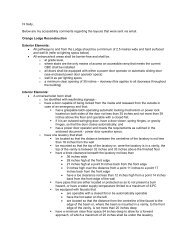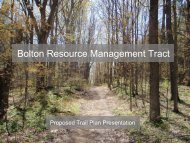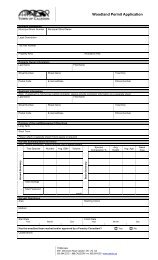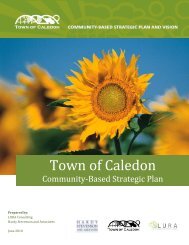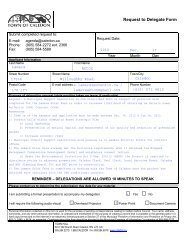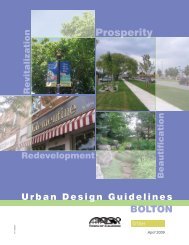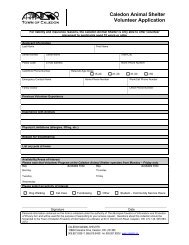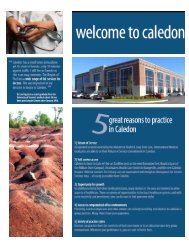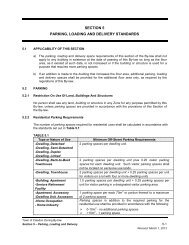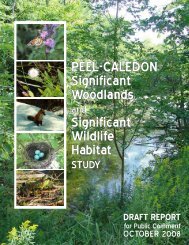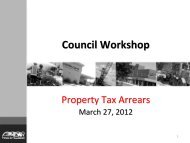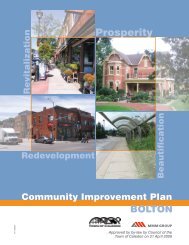Rockside Cultural Heritage Landscape Study - Town of Caledon
Rockside Cultural Heritage Landscape Study - Town of Caledon
Rockside Cultural Heritage Landscape Study - Town of Caledon
Create successful ePaper yourself
Turn your PDF publications into a flip-book with our unique Google optimized e-Paper software.
<strong>Rockside</strong> <strong>Cultural</strong> <strong>Heritage</strong> <strong>Landscape</strong> <strong>Study</strong><br />
<strong>Town</strong> <strong>of</strong> <strong>Caledon</strong><br />
for a number <strong>of</strong> small, disaffected farming communities in the orbit <strong>of</strong> York (Toronto),<br />
the Rebellion <strong>of</strong> 1837. When William Lyon Mackenzie was in flight after the battle <strong>of</strong><br />
Montgomery’s Tavern, he and fourteen followers are said to have been hidden for two<br />
weeks in a cave on the John MacDonald Jr. farm (Lot 1 E½ Concession 4 WHS,<br />
Inventory #7), kept alive by MacDonald’s wife who smuggled food to them despite the<br />
nearby presence <strong>of</strong> government troops 11 .<br />
The other site associated with the broader<br />
issues <strong>of</strong> the time was the Grange<br />
(McLaren’s Castle), the baronial Scottish<br />
castle built by Alex McLaren (Lot 5 E½<br />
Concession 4 WHS, Inventory #1) and<br />
completed in 1864.<br />
McLaren’s Castle (W.I. Collection, photo courtesy<br />
<strong>of</strong> the McLaren family)<br />
The building itself, with its grand scale,<br />
meticulous stone detailing and prominent<br />
view, became a landmark, known well<br />
beyond the area. McLaren himself was<br />
involved in local politics both formally as<br />
Reeve <strong>of</strong> the <strong>Town</strong>ship but also as the<br />
catalyst behind the forming <strong>of</strong> ‘the<br />
Grangers’, the first united farmers’ group<br />
which met in the attic <strong>of</strong> the Castle 12 .<br />
Patterns <strong>of</strong> Spatial Organization<br />
Survey<br />
The survey <strong>of</strong> <strong>Caledon</strong> <strong>Town</strong>ship was completed in 1819 by Samuel Rykman and was<br />
one <strong>of</strong> the first to be undertaken using the double-front system. In this system the<br />
common unit <strong>of</strong> concession is the half-lot <strong>of</strong> 100 acres with each half <strong>of</strong> the 200 acre lot<br />
fronting on a different concession line road. These half lots are almost square.<br />
Concessions run essentially north-south in this region (actually northwest). At every five<br />
lots there is an allowance for a Sideroad.<br />
In <strong>Caledon</strong> <strong>Town</strong>ship, concessions were numbered east and west from Hurontario Street<br />
(now Highway 10) with a number <strong>of</strong> the west concession roads unable to be run across<br />
the edge <strong>of</strong> the Niagara Escarpment. The earliest <strong>of</strong> the <strong>Rockside</strong> Pioneers were granted<br />
50 acres <strong>of</strong> land with the other 50 acres <strong>of</strong> the half-lot potentially held in reserve for the<br />
settler until such time as all settlement duties had been performed and a small fee paid 13 .<br />
The nature <strong>of</strong> the double front survey described above and the original granting <strong>of</strong> land as<br />
50 acre (1/4 lot) parcels have had a lasting effect on the pattern <strong>of</strong> settlement in <strong>Rockside</strong>.<br />
11 Berniece Trimble, Belfountain” Caves, Castles and Quarries. (Erin: Herrington Printing, 1975) p.28<br />
12 Ibid. p23-27.<br />
13 Robert Crichton, The <strong>Rockside</strong> Pioneers. (Cheltenham: Boston Mills Press, 1977) Chapter 2 (no page numbers).<br />
13



